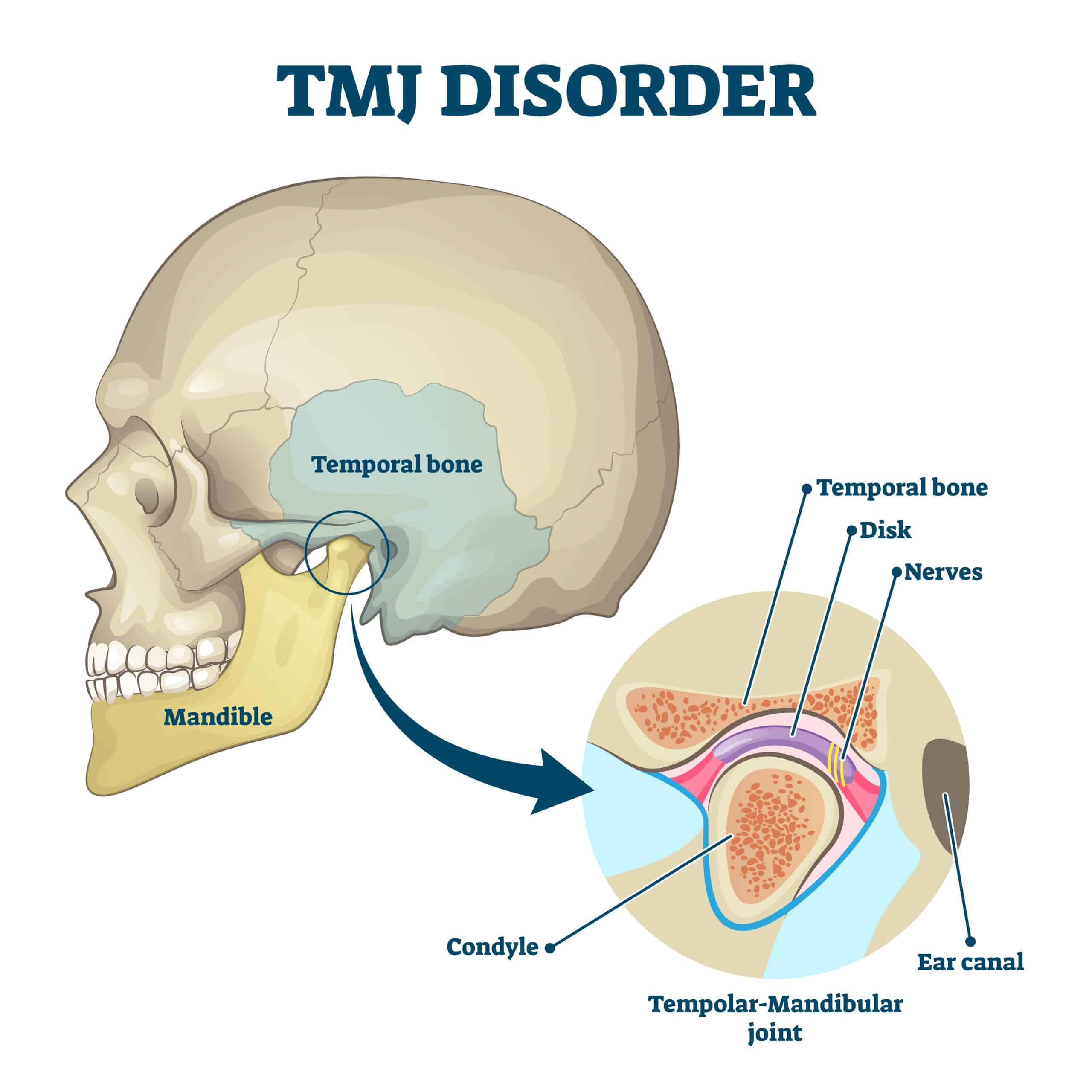What Is TMJ and What Can I Do About It?

TMJ disorder is one of the most prevalent complaints from dental patients all over the world. According to the most recent data, TMJ affects over 10 million patients in the US alone. Thankfully, it is not always a severe condition for patients to be worried about. Treatments for TMJ disorder exist, and it will often go away completely. Problems tend to arise when this condition is left untreated.
What is TMJ Disorder?
TMJ stands for temporomandibular joint, which is the connection of your jawbone and skull. This is a hinge joint with a disk between the two bones, allowing the joint to slide back and forth. You can feel this joint by placing your fingers on either side of your face, just by your ears. Open and close your mouth, and you will feel a bone moving up and down.

TMJ disorder is where this joint becomes compromised and results in stiffness and pain. It tends to happen when the soft cartilage disc between the bones deteriorates and fails to protect the bones. As a result, they can rub against one another, leading to varying degrees of pain. It can be hard for you to do simple acts – like chewing food or opening your mouth wide. The pain doesn’t have to be constant but can come and go depending on your lifestyle habits. For instance, if you talk a lot during the day, your TMJ will hurt more than someone that isn’t very vocal.
Will TMJ Disorder Go Away On Its Own?
There’s a significant debate surrounding this topic in the world of dentistry. Some argue that TMJ disorders will eventually go away on their own. However, this is somewhat misleading as most patients only see improvements when adopting minor lifestyle changes. For instance, if a patient complains of TMJ pain, it’s often suggested that they take it easy and avoid foods that require lots of chewing. It’s a minor adaptation, but resting the joint for a few days can be all that’s needed to see results.
In essence, the answer to the question is no, TMJ disorder won’t magically go away if you do nothing at all. A more accurate answer is that it can be solved without resorting to drastic measures – like TMJ surgery.
What Happens If TMJ Disorder Is Not Treated?
If TMJ disorders are left untreated, what do you suspect will happen? Remember, this is a condition affecting a vital joint in the face. As with all other joint conditions throughout the body, a lack of treatment will result in a worsening of the symptoms. Any pain a patient feels will get worse over time, and it can lead to more debilitating factors. Patients with severe TMJ disorder may struggle to eat and can find it difficult to talk.
These are extreme examples, and it usually doesn’t get that far. This is because TMJ can be treated very easily without any complex procedures. Effectively, there’s no reason for it to be left untreated. If it is, you will likely end up with more serious joint issues and inflammatory diseases – like arthritis.
Can TMJ Be Treated at Home?
The reason TMJ is rarely untreated is that you can follow simple practices to treat it at home. It’s a case of recognizing the symptoms and alerting yourself to the triggers. When you’re aware of what might set off some TMJ pain, you can work to stop these triggers and let your jaw heal.
Here are the three main things you can do to treat this problem by yourself:
Change Your Eating Habits
This has been mentioned already, but changing your eating habits gives your jaw muscles a rest. It reduces the tension on the joint, letting everything slow down and heal. Stay away from foods that are notoriously difficult to chew – like sticky toffees or chewing gum. Instead, eat softer foods that don’t put too much stress on your jaw. You could also cut your food into smaller chunks, which will allow you to eat slightly tougher foods without the effort.
After a week or so, you should see drastic improvements in your TMJ and a reduction in pain. It’s a good idea to avoid overly troublesome foods in the future, to prevent flare-ups.
Self-Massage TMJ Treatment
Another tactic involves lightly massaging the area around this joint. It can ease a lot of tension and get the muscles to relax. All you have to do is place a finger or two near the joint and slowly make circular motions. You’ll be surprised at how quickly this provides a sense of relief.
Hot & Cold Treatment
Lastly, you can try some hot or cold TMJ therapy on the site. Heat packs will help ease tension and loosen up the joint when it feels stiff. Ice packs are useful at easing pain if your jaw feels swollen and painful. While these don’t solve the problem, they can provide temporary relief.
Get TMJ Treatment from Rinaldi Dental Arts
Overall, the best way to treat TMJ disorder is to seek help from a qualified dentist. At Rinaldi Dental Arts, we offer specialized TMJ Therapy services for any patients with this issue. Dr. Rinaldi will provide a full consultation, determining the extent of your issue. From here, a range of services will be considered to find the best TMJ treatment.
TMJ Therapy tends to consist of professional massages and exercise programs that relieve tension and build up strength around the joint. This is the best way to see long-term relief from TMJ pain. It addresses the root of the issue by building more stability around the joint and tackling tightness in the surrounding muscles. Dr. Rinaldic can also provide patients with removable appliances that prevent things like teeth grinding while sleeping. This will further reduce the tension on the TMJ joint, alleviating symptoms a lot faster.
Many other therapies and TMJ treatments are available, depending on the patient in question. If you suffer from TMJ pain, it’s advised that you contact Rinaldi Dental Arts to book a consultation today.
